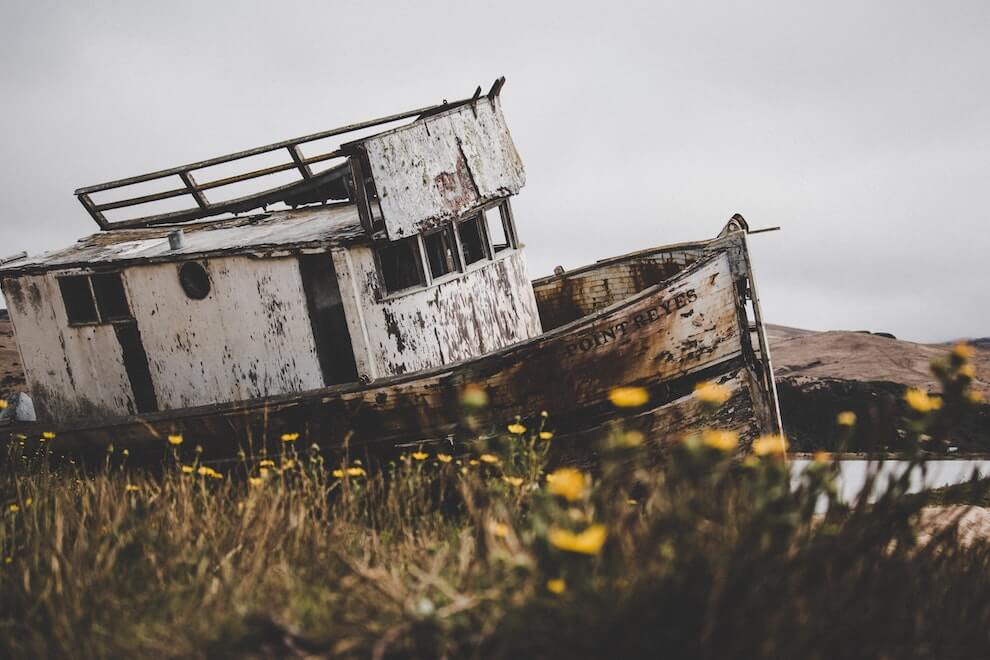As people took to the seas many ships failed to reach their destination so the sea bed is now dotted with shipwrecks. However other ships have lost their way close to shore. Now many are a part of the beaches they ran aground on. Here are some shipwrecks and the story behind their demise.
M/S Cabo Santa Maria
In 1968 Francisco Franco, a Spanish dictator sent a cargo ship with various gifts to his supporters. The M/S Cabo Santa Maria needed to arrive in Brazil and Argentina. Alas not even halfway through the journey, the ship ran aground in Cape Verde. The shore of Boa Vista Island is now its final resting place.
Residents of the islands tried to dislodge the ship but it did not work, so instead the crew was evacuated. That only left the entire precious cargo to deal with. For an entire year, the islanders have endeavored to carry the cargo out of the ship, using mules and donkeys.
Now, 50 years later the cargo ship is slowly falling apart at the mercy of the elements. In time it has become a touristic symbol of Boa Vista Island.
SS Maheno
SS Maheno was originally an ocean liner constructed in Scotland and launched in 1905. It serviced routes between Sydney and Melbourne along with ports in New Zealand.
Its uses changed soon after the first World War began. The ship was transformed into a hospital ship, painted white with green stripes along the sides and red crosses.
The ship carried patients off from the Gallipoli Campaign to Malta. It served the English Channel and carried out wounded soldiers from the Western Front. The brutal battle of Sonne was where most of its passengers came from. Some of its many trips from New Zealand to the British Isles carried patients and wounded.
At the end of the war it was released from duty, but remained in commercial use until 1935. It was sold to a shipbreaker’s yard in Osaka, Japan. SS Maheno left the port of Sydney on July 3rd, 1935 towed by the ship Oonah. The Maheno had its propellers removed beforehand.
On July 7th, a cyclone hit the towing ships and the Maheno’s tow broke off. The ship vanishing with the skeleton crew of eight still onboard. It found on July 10th, by an aircraft pilot on the shores of Fraser Island where it was beached. Later on July 12th, the crew was rescued by the Oonah ship.
The SS Maheno could not be refloated. It was stripped of its fittings and now still lies on the shore of Fraser Island. Apopular tourist attraction, its appearance changes from year to year.
The Dimitrios
The Dimitrios was a small Greek cargo ship, registered at the prefecture of Piraeus. Ever since December 23, 1981, the ship has been stranded on a beach in Valtaki, Evrotas Municipality. How it came to be stranded on the beach was very peculiar.
The Dimitrios docked on December 4th, 1980 due to the captain’s medical issues. While docking, financial problems started erupting among the crew. Technical difficulties emerged with the engine, and insurance measures all lead to the crew getting fired.
It was docked at Gythio until June 1981, when it was declared unsafe due to wear on the docking ropes and water flooding the hull. The harbor authorities wanted it moved to a safe anchorage location but the owners responded late in November 1981.
The Dimitrios was temporarily anchored and on November 9th. Harsh weather conditions broke the anchorage and swept the entire ship away finding its final resting place at a beach in Valtaki on December 23rd. No one tried to recover or refloat it, they simply abandoned the ship.
There have been many speculations as to why no one bothered to save the ship. Some claiming it was used to smuggle cigarettes between Turkey and Italy and that when caught the Dimitrios was released intentionally to the waves.
It now serves as a tourist attraction on the sandy shores of a beach in Greece, with its imposing mast silhouetting the skyline.
MV E Evangelia
MV E Evangelia was a refrigerated Greek cargo ship, built in Belfast and launched on May 28, 1942. It served in the Second World War delivering cargo from England to Australia, from the US to Argentina and everywhere in between.
The ship underwent four different name changes, Empire Strength, Saxon Star, Redbrook, and finally Evangelia.
On October 15, 1968, the Evangelia was carrying ballast cargo from Rijeka, Yugoslavia to the port of Constanta, Romania on the Black Sea. It ran aground 30 kilometers South of its destination, near the seaside resort of Costinesti.
Some urban legends claim that the ship intentionally ran aground to collect its insurance. It locally wears the name the Shipwreck of Costinesti and it provides a tourist attraction along with a sandy beach.
Aral Sea ship graveyard
Unlike any of the other shipwrecks mentioned this place contains multiple ships littered on the ground with no water in sight. These ships did not run aground or accidentally collide with a rocky sea bed, they just ran out of water to float on.
The Aral Sea was the fourth-largest freshwater lake in the world. Extensive use of its water for irrigation and deviation of rivers flowing from Russia, shrunk the Aral Sea into the dry husk that it is today.
The ship graveyard that now decorates the empty sands is just a bitter memory of the worst environmental disasters in recent times.
Final considerations
Shipwrecks around the world hold an odd fascination for many, and this is especially true when you spend a vacation on the beach. Confronting shipwrecks at the bottom of a sea is very different than having to see it peeking out from the shore side.



Leave a Comment